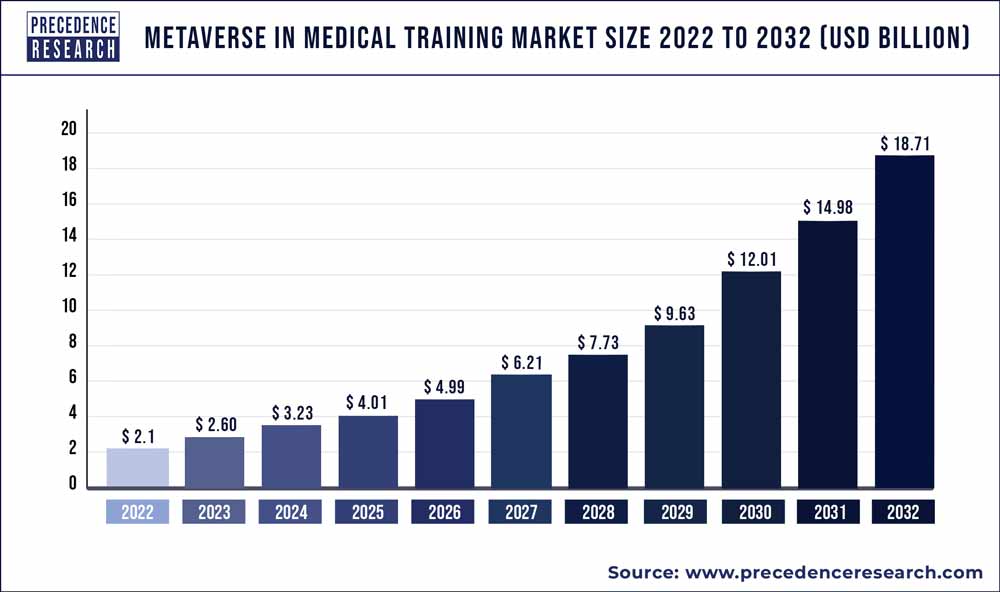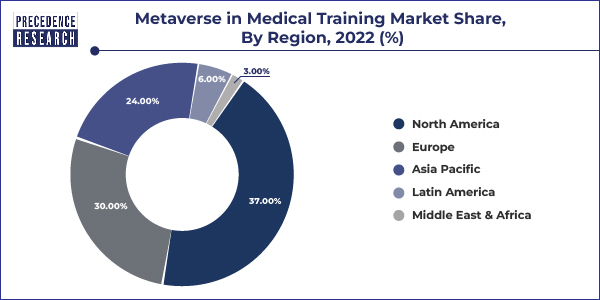Metaverse In Medical Training Market Size, Share, Trend, Report 2032
The metaverse in medical training market size was estimated at USD 2.60 billion in 2023 and is projected to surpass USD 18.71 billion by 2032 with a significant CAGR of 24.50% from 2023 to 2032.

Key Takeaways
- North America contributed more than 37% of revenue share in 2022.
- Asia Pacific is estimated to expand the fastest CAGR between 2023 and 2032.
- The hardware segment has held the largest market share of 68% in 2022.
- The software segment is anticipated to grow at a remarkable CAGR of 26.3% between 2023 and 2032.
- The VR segment generated over 48% of revenue share in 2022.
- The AR segment is expected to expand at the fastest CAGR over the projected period.
- The VR headsets segment generated over 46% of revenue share in 2022.
- The mixed reality platforms segment is expected to expand at the fastest CAGR over the projected period.
- The medical schools and universities segment had the largest market share of 41% in 2022.
- The hospitals and healthcare institutions segment is expected to expand at the fastest CAGR over the projected period.
The metaverse in medical training market is a dynamic and innovative sector at the intersection of healthcare and virtual reality technologies. It represents a revolutionary approach to medical education, leveraging immersive experiences and simulations to enhance the training of healthcare professionals. This transformative paradigm shift in medical training not only addresses traditional challenges but also opens up new possibilities for hands-on learning and skill development in a virtual environment.
Region Snapshot
The adoption and growth of the Metaverse in Medical Training vary across regions, with a notable trend of increased implementation in technologically advanced areas. Developed regions, such as North America and Europe, have witnessed substantial investment and integration of metaverse technologies in medical education institutions.

The Asia-Pacific region, driven by emerging economies and a growing focus on healthcare infrastructure, is also experiencing a surge in the adoption of the metaverse for medical training. As the benefits and accessibility of metaverse-based medical education become more apparent, it is anticipated that its influence will continue to expand globally, transcending geographical boundaries.
Growth Factors
Several key factors contribute to the rapid growth of the Metaverse in Medical Training market. The increasing demand for highly skilled healthcare professionals, coupled with the limitations of traditional training methods, has fueled the adoption of virtual reality in medical education. The ability of the metaverse to simulate realistic medical scenarios, surgeries, and patient interactions provides trainees with invaluable practical experience, ultimately improving their competency and confidence. Additionally, advancements in technology, such as augmented reality (AR) and artificial intelligence (AI), further enrich the immersive learning experience, making the metaverse an indispensable tool in shaping the future of medical training.
Metaverse in Medical Training Market Scope
| Report Coverage | Details |
| Growth Rate from 2023 to 2032 | CAGR of 24.50% |
| Market Size in 2023 | USD 2.60 Billion |
| Market Size by 2032 | USD 18.71 Billion |
| Largest Market | North America |
| Base Year | 2022 |
| Forecast Period | 2023 to 2032 |
| Segments Covered | By Component, By Technology, By Devices, and By End User |
| Regions Covered | North America, Europe, Asia-Pacific, Latin America, and Middle East & Africa |
Component:
The Metaverse in Medical Training Market comprises various essential components. Virtual Reality (VR) and Augmented Reality (AR) technologies form the backbone of immersive experiences, providing realistic simulations. Additionally, software solutions play a crucial role in creating and managing virtual environments, while hardware components such as headsets and input devices contribute to the overall user experience. The synergy of these components ensures a comprehensive and effective metaverse-based medical training ecosystem.
Technology:
Within the Metaverse in Medical Training Market, technology plays a pivotal role in shaping the training landscape. Virtual Reality technology enables fully immersive simulations, replicating surgical procedures and medical scenarios in a realistic 3D environment. Augmented Reality, on the other hand, overlays digital information onto the real-world, enhancing training by providing contextually relevant data during medical procedures. The integration of Artificial Intelligence (AI) further refines simulations, adapting scenarios based on user interactions and feedback.
Devices:
The devices segment of the Metaverse in Medical Training Market encompasses the hardware necessary for users to engage with virtual environments. VR headsets, ranging from tethered high-end devices to standalone options, provide the visual and auditory immersion required for realistic simulations. AR devices, including smart glasses, offer a mixed-reality experience, blending virtual and real-world elements. Input devices such as motion controllers and haptic feedback tools enhance user interaction, allowing practitioners to engage with virtual medical scenarios in a tactile manner.
End User:
The Metaverse in Medical Training Market caters to a diverse range of end-users within the healthcare ecosystem. Medical professionals, including surgeons, nurses, and physicians, are primary beneficiaries, utilizing metaverse-based training to refine their skills and stay updated on the latest medical practices. Educational institutions, such as medical schools and training centers, leverage the metaverse to enhance their curriculum and provide students with hands-on experiences. Healthcare organizations adopt metaverse technologies for continuous professional development, ensuring their staff remains proficient in evolving medical procedures and protocols.
Metaverse in Medical Training Market Players
- Oculus VR, LLC
- Osso VR
- Touch Surgery
- Medical Realities
- Precision OS
- FundamentalVR
- VirtaMed
- CAE Healthcare
- 3D Systems Corporation
- Medtronic
- ImmersiveTouch Inc.
- Microsoft Corporation
- Samsung Electronics
- Philips Healthcare
- Surgical Science
Segments Covered in the Report
By Component
- Software
- Hardware
By Technology
- AR
- VR
- AI
- MR
By Devices
- VR Headsets
- AR Devices
- Mixed Reality Platforms
By End User
- Medical Schools and Universities
- Hospitals and Healthcare Institutions
- Pharmaceutical Companies
- Others
By Geography
- North America
- Europe
- Asia-Pacific
- Latin America
- Middle East and Africa
Recent Developments
- In 2023, NVIDIA Corporation (US) and Microsoft (US) joined forces to bridge Microsoft 365 apps with NVIDIA Omniverse. This collaboration aims to enable digital transformation, facilitate industrial metaverse integration, and empower the training of advanced generative AI models, among other applications.
- In 2022, Ventyn enters the healthcare metaverse by coordination with 8chili HintVR virtual reality platform. This integration empowers care coordination, utilizing machine intelligence, virtual training, patient engagement, education, and health coaching. The convergence of 3D content and digital health apps expands the possibilities of healthcare innovation.
- In 2022, GE Healthcare (US) partnered with MediviewXR (US) to co-create the OmnifyXR medical imaging system. This collaboration is dedicated to advancing medical imaging technology, potentially transforming how healthcare professionals interact with and utilize medical data for diagnosis and treatment.
Contact Us:
Mr. Alex
Sales Manager
Call: +1 9197 992 333
Email: sales@precedenceresearch.com
Web: https://www.precedenceresearch.com
Blog: https://www.expresswebwire.com/
Blog: https://www.uswebwire.com/
Blog: https://www.dailytechbulletin.com/
Blog: https://www.autoindustrybulletin.com/
